#Iwatayama
Explore tagged Tumblr posts
Photo










𝙸𝚠𝚊𝚝𝚊𝚢𝚊𝚖𝚊 𝙼𝚘𝚗𝚔𝚎𝚢 𝙿𝚊𝚛𝚔 - 𝙰𝚛𝚊𝚜𝚑𝚒𝚢𝚊𝚖𝚊, 𝙺𝚢𝚘𝚝𝚘 𝟸0𝟸𝟸.0𝟾.𝟹𝟷
#monkey#Park#kyoto#japan#arashiyama#iwatayama#photography#photographer#photographers#photo#original photography#original content#original photography blog#japan photos
4 notes
·
View notes
Text

#Iwatayama Monkey Park#Monkey Park#Macaque#monkeys#baby monkey#Kyoto#Japan#Kyoto travel#japan travel
10 notes
·
View notes
Text
youtube
Japan is a country with a rich cultural heritage, stunning natural landscapes, and a blend of modern and traditional elements. Whether you're interested in exploring historical temples, enjoying the beauty of cherry blossoms, or experiencing cutting-edge technology in bustling cities, Japan has something for everyone. Here's a guide to help you plan your visit to Japan:
1. Tokyo:
Asakusa: Visit Senso-ji Temple and Nakamise Shopping Street.
Shibuya Crossing: Experience the iconic pedestrian scramble.
Akihabara: Explore the electronics and anime district.
Tsukiji Outer Market: Try fresh sushi and seafood.
2. Kyoto:
Fushimi Inari Shrine: Walk through thousands of red torii gates.
Kinkaku-ji (Golden Pavilion): Admire the stunning Zen Buddhist temple.
Arashiyama: Explore the bamboo groves and visit the Iwatayama Monkey Park.
3. Osaka:
Osaka Castle: Visit this historic castle surrounded by a beautiful park.
Dotonbori: Experience vibrant nightlife and try local street food.
Universal Studios Japan: Enjoy the theme park attractions.
4. Hiroshima:
Peace Memorial Park: Reflect on the city's history and visit the Atomic Bomb Dome.
Miyajima Island: Explore the iconic "floating" torii gate at Itsukushima Shrine.
5. Nara:
Nara Park: Interact with friendly deer and visit Todai-ji Temple.
Kasuga Taisha Shrine: Explore the lantern-lined paths.
6. Hokkaido:
Sapporo: Enjoy winter sports, the Snow Festival, and delicious local cuisine.
Shikisai-no-Oka Flower Fields: Visit colorful flower fields in Biei.
7. Kanazawa:
Kenrokuen Garden: Experience one of Japan's three most beautiful landscape gardens.
Higashi Chaya District: Wander through well-preserved geisha districts.
8. Mount Fuji:
Chureito Pagoda: Capture stunning views of Mount Fuji.
Lake Kawaguchi: Enjoy the scenery around this picturesque lake.
9. Okinawa:
Shurijo Castle: Explore the reconstructed castle in Naha.
Okinawa Churaumi Aquarium: Visit one of the largest aquariums in the world.
10. Japanese Onsen (Hot Springs):
Experience the relaxation of traditional hot springs, such as those in Hakone or Beppu.
11. Japanese Gardens:
Visit traditional Japanese gardens like Ritsurin Koen in Takamatsu or Korakuen in Okayama.
12. Cherry Blossom Season:
Plan your visit during spring (late March to early April) to witness the breathtaking cherry blossoms.
13. Traditional Tea Ceremony:
Experience a traditional Japanese tea ceremony for a glimpse into Japanese culture.
14. Sumo Wrestling:
Attend a sumo wrestling match or visit a sumo training stable.
15. Japanese Cuisine:
Try sushi, ramen, tempura, kaiseki (multi-course meal), and other local specialties.
Tips:
Transportation: Utilize Japan's efficient and punctual public transportation, including the Shinkansen (bullet train).
Cash: While credit cards are accepted in urban areas, it's advisable to have some cash, especially in rural regions.
Language: English may not be widely spoken, so learning a few basic Japanese phrases can be helpful.
Japan offers a unique blend of tradition and innovation, and each region has its own distinct charm. Whether you're interested in history, nature, or modern city life, Japan provides a diverse range of experiences. Enjoy your travels in the Land of the Rising Sun!
#japan#japon#JapanTravel#ExploreJapan#JapanAdventures#VisitJapan#PhotographyJapan#JapanLovers#JapanVibes#JapanNature#JapanCulture#JapanExperience#JapanTrip#DiscoverJapan#JapanHoliday#JapanDreams#JapanWanderlust#JapanBeautiful#JapanViews#JapanLandscapes#JapanCityLife#JapanMemories#Youtube
3 notes
·
View notes
Text
June 16th, Arashiyama Bamboo forest and Iwatayama Monkey Park
Today started off as usual. I got up, and went to breakfast, and then I went to 7/11 for a coffee. Their coffee here is not rich enough. They just put milk in it. I really need the full six ounces of heavy cream I put in mine. we visited two places, Arashiyama Bamboo Forest and the nearby monkey park.
The ride was only about thirty minutes and I was able to get a seat on the train. Arashiyama forest was great. The feeling of being in the forest was so uplifting. The scenery by the nearby town and river really made me feel jubilant. I had a nice lunch of takoyaki and fried chicken, as well as a shaved ice with strawberries and condensed milk.
However, the hike up the mountain to get to the monkeys was gruelling. It was the Bataan death march. I was exhausted by the time I got to the top, but there was an empty bench with a great view of Kyoto, so I was good to go. We saw a lot of monkeys up there, my brother would be jealous. He loves monkeys. I agree, they’re pretty cool. These ones seemed quite friendly.
Academic reflection
Arashiyama forest and the Nonomiya shrine were sites in the Tale of Genji. I can see Genji, who was a real Cassanova, going to the shrine to ask for reprieve from his endless sexual frustration. a flawed character to say the least. He went to this place to have an affair with Lady Rokujo. However, the Tale of Genji is still a world renowned novel for its critique of elite Japanese court culture, and it was interesting and worthwhile to see the setting of some of the story as it is now. Not even the most holy shrine or most pristine forest could help Genji, though,
Arashiyama is also a special place because the forest here is essentially untouched. There are a few trails, and many tourists pass through the bamboo grove, but this is another great example of Japan’s rich vegetation in close proximity to a densely populated urban area. Only minimal human efforts to plant trees are conducted here. I think Japan’s natural beauty is second only to the U.S., and I think their forest management is only second to the U.S. as well, which is why we can enjoy natural landscapes in both places.




2 notes
·
View notes
Text
Japan Adventures – Day 7: Exploring Arashiyama and Kyoto’s Hidden Gems
Day 7 of our Japan Adventures
Morning: Iwatayama Monkey Park Adventure We had to make some minor changes to our itinerary as we had already covered Kinkaku-ji when we first arrived and couldn’t get seats on the Sagano Scenic Train. We started the day by taking a direct bus to Iwatayama Monkey Park. Upon arriving at the Arashiyama bus stop, my kids were intrigued by the Katsura River, where they went down to the riverbank to…
0 notes
Text
Monday, June 17, 2024
Kyoto Railway Museum, Iwatayama Monkey Park, and Samurai Museum
Today began at the normal time of around 9, where we got ready and headed over to the Kyoto Railway Museum, which I was pretty excited for as I had heard there were tons of decommissioned trains to see there. Before getting inside we stopped at a small restaurant nearby to get some food and I ended up settling on a Teriyaki Chicken Pizza, which is something I have never heard of outside of Japan, and figured I like them both separately so I may as well give it a try! The pizza itself was not bad, it was a bit floppy but the combination was surprisingly good.

After this we headed to the museum and were immediately greeted by an older passenger train as well as one of the first Bullet Trains produced. These were both very cool to see up close, and I enjoyed getting to see how far along the Bullet Train has come in terms of both speed and design. This O Series Shinkansen could only reach speeds of about 130 mph, whereas the newer Töhoku Shinkansen can get to above 200 mph. I also couldn't believe that the Shinkansen originally began operations in 1964, which is insane to think they've had ultra high speed rail travel for 60 years now.


The museum also had a really cool model train exhibit showing a large portion of Kyoto and displaying many of the famous trains that one might encounter. They also had a massive outdoor railway roundhouse which displayed tons of really old locomotives. After the museum we walked around Kyoto for a bit before heading to a train bound for Arashiyama to see some monkeys. Once in Arashiyama we made way to the mountain to hike up to the top where we can see the monkey park. With this being my second time here, I had already experienced but like many other second visits, it was nice not being here while it was raining and it is always cool to see the same things on a different day as I can get more out of it the second time around. There seemed to be more people this time and less monkeys out and about, although we still got to feed them and see them all walking around as per usual.

We spent a good amount of time here monkeying around before making our way back down the mountain. On the way out we we decently hungry and also all simultaneously in the mood for ice cream so we scouted out a place to get some soft serve. This wound up being a cute Rilakkuma themed ice cream place which was not only tasty but also & 7 EDul. While this definitely hit the spot we were still pretty hungry for dinner and walked around the area for a bit trying to find someplace to eat, however it seemed to all be dessert places for some reason. Nonetheless we eventually found a place serving meat and rice boxes which I will never turn down. The meal was pretty tasty and I left the restaurant feeling satisfied and satiated - two of my favorite S adjectives.


After dinner, we wound up taking a taxi back to Kyoto and ended up near the Shijo Kawaramachi area where we walked around some looking for something to do before heading back to the hotel.

1 note
·
View note
Text
Kyoto: A Mesmerizing Journey Through Time and Tranquility
Kyoto, the cultural heart of Japan, is a city that breathes history and whispers tales of ancient traditions. In this article, we invite you to explore the best places in Kyoto, where every step is a journey through time and every sight is a glimpse into the city's timeless allure.
Let's read it out.
Kinkaku-ji: The Golden Pavilion
Kinkaku-ji, or the Golden Pavilion, is an iconic symbol of Kyoto's splendor. The Zen Buddhist temple is adorned with gold leaf, reflecting on the still waters of its surrounding pond. Explore the meticulously landscaped gardens as you bask in the serenity of this golden masterpiece. The reflection of Kinkaku-ji in the pond creates a surreal atmosphere, making it a must-visit destination for those seeking tranquility and architectural marvels.
Fushimi Inari Taisha: Gates to Eternity
Step into a realm of spiritual mystique at Fushimi Inari Taisha, famous for its mesmerizing Torii gates that form pathways up the sacred Mount Inari. The vibrant red gates create a captivating tunnel leading to the mountain's summit, where panoramic views of Kyoto await. The hike is not just a physical journey, but a symbolic ascent into the spiritual heart of Kyoto.
Arashiyama Bamboo Grove: Whispers of the Forest
Find yourself immersed in the enchanting Arashiyama Bamboo Grove, a natural wonder that feels like stepping into another world. The towering bamboo stalks create a mesmerizing canopy, allowing dappled sunlight to filter through. Stroll along the winding paths and embrace the tranquility of this bamboo sanctuary. A visit to the nearby Iwatayama Monkey Park adds an extra layer of wildlife charm to your Arashiyama experience.
Gion District: Geisha Grace and Historic Charm
Transport yourself to the bygone era of Kyoto in the Gion District, renowned for its well-preserved historic streets and traditional wooden machiya houses. Gion is the epitome of Kyoto's cultural heritage, and it's not uncommon to catch a glimpse of geishas gracefully gliding through its narrow alleys. Explore Hanami-koji, the main street of Gion, for a taste of Kyoto's elegant past.
Kiyomizu-Dera: The Pure Water Temple
Perched on the hills east of Kyoto, Kiyomizu-dera offers panoramic views of the city and is celebrated for its wooden terrace that seems to float in the air. The temple is dedicated to the deity of mercy and compassion, and its clear spring water is believed to have healing properties. Visit during the cherry blossom season for a breathtaking display of nature's beauty.
Conclusion
Kyoto is a city that unfolds like a beautiful tapestry, weaving together the threads of tradition, spirituality, and natural splendor. Each of these destinations invites you to savor the essence of Kyoto, a city where the past and present dance in harmony, creating an unforgettable tapestry of cultural richness. If you are looking for the best Japan tourists spots Kyoto can be the right choice for you.
#holidays to japan#japan tourism#japan tourists spots#japan itinerary#japan travel#places to visit in japan
1 note
·
View note
Text
Le 1er août
Direction la gare d'Arashiyama. Le quartier nature de l’ouest de Kyoto, au pied du mont Arashi, Arashiyama abrite entre autres la forêt de bambou et le parc des singes.
À la sortie de la gare une exposition permanente, La forêt de kimonos est un ensemble d’environ six cents poteaux cylindriques entourés de tissus de kimono japonais, et disposés le long d’un chemin pavé dans la gare terminus de Randen à Arashiyama.




Pont Togetsukyo, la forêt des montagnes environnante est composée de cerisier et d’érables, les fleurs rose et blanche et les feuilles rouge et jaune, mais pas en même temps! À emprunter à l’automne et/ou au printemps
Iwatayama : Le parc des singes
Tout près, au sud du pont Togetsukyo, se trouve un parc naturel. Iwatayama est une montagne pas très haute qui abrite un parc où des dizaines de singes vivent dans leur environnement naturel. Un sentier balisé nous mène au sommet, suite à une ascension d’une trentaine de minute on a une très belle vue de Kyoto et la présence de dizaines de singes (macaques japonais) qui se promènent tout autour de nous. Pour pouvoir les nourrir, il faut entrer dans une cage. Ce qu’il faut savoir, c’est que ce sont des singes sauvages, les regarder dans les yeux pourrait être perçu comme une agression!
Louise, Mélissa-Anne et moi avons pris plaisir à entrer dans la cage, qui est plus une cabane aux fenêtres grillagées, pour nourrir les singes. C’est sûr que les plus grands intimident les plus petits pour avoir un max de nourriture. Il m’a fallu user de ruse pour en donner aux plus petits. Au sortir de la cage, entourés de singe on a pris le temps de contempler la vue de Kyoto.
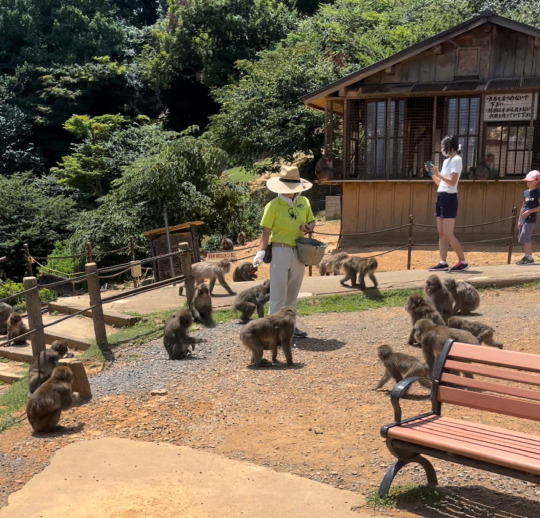
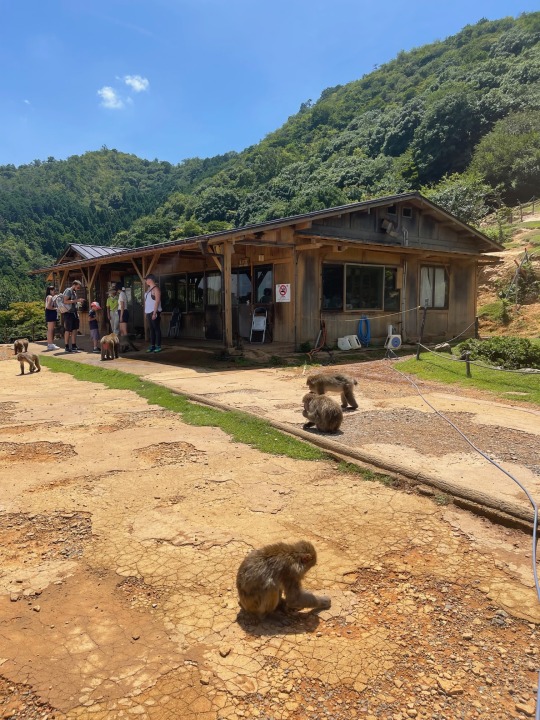


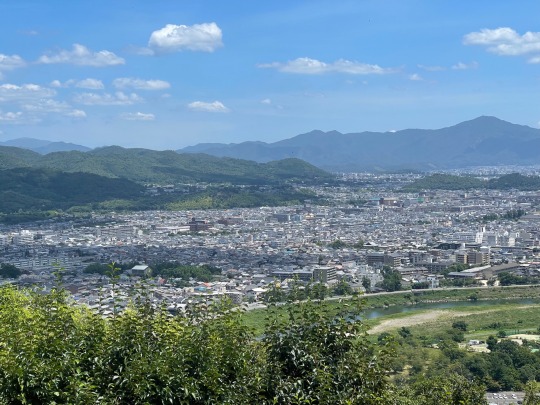
On redescend de la montagne aux singes, traverse en sens inverse le pont Togetsukyo et on se dirige vers la forêt de bambous géants qui se trouve le long de la rivière Katsura. Tout à côté se trouve le Tenryu-ji. Pour les Japonais, le bambou représente la force et la prospérité, le bambou est aussi réputé pour repousser les forces du mal, ce qui explique la proximité du Tenryu-ji (temple bouddhiste zen de l’école Rinzai fondé en 1349 par le shogun Takauji Ashikaga).
On se promène dans les sentiers aménagés, c’est silencieux et paisible. Je me sens calme et reposé, c’est impressionnant.
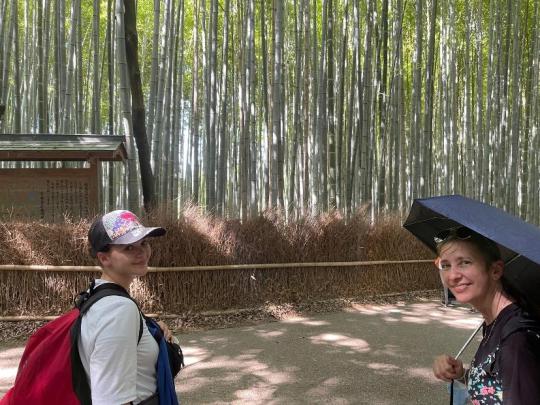


De retour à la gare d'Arashiyama, on profite du bain chaud de pied, qui fait partie de la gare proprement dite. Au Japon, les bains se nomment onsen. Un onsen est un bain d’eau chaude provenant de sources volcaniques. Pour le bain de la gare, je ne sais pas si l’eau provient de source volcanique mais après une journée de marche, ce fut très apprécié.


Gion : Quartier des geishas
Kyoto fut la capitale du Japon pendant plus de 1000 ans. Gion est un quartier mythique qui fut édifié au moyen âge à côté du sanctuaire Yasaka. Ce quartier est réputé pour ses geishas.
En soirée, on a fait une excursion à Gion pour y voir des geishas. Après avoir arpenté les rues étroites et moyenâgeuses on est revenus bredouille. En cette période de pandémie où le touriste n’est pas admis, et qu’il faut un visa spécial pour entrer au Japon, l’industrie touristique souffre. Mais on en croisera dans d’autres quartiers à l’occasion.
Contrairement à la croyance populaire occidentale, la geisha n’est pas une prostituée. C’est, pour les Japonais, une artiste des arts traditionnels du Japon, soit entre autres le service du thé, jouer d’un instrument, le théâtre, la danse, le chant. Elle travaille généralement dans une maison de thé, une auberge, ou au restaurant.


次-suivant
0 notes
Text
June 16 - Arashiyama Bamboo Forest and Iwatayama Monkey Park
Today we went to the Arashiyama Bamboo Forest and the Iwatayama Monkey Park. We started off by heading to the bamboo forest. In the train station, we ran into this silly little robot guy just vibing and going around the station.

It took like an hour total for us to get to the bamboo forest. Emily and Ana had gotten there early to rent Kimonos and I have no idea how they managed to and survived hiking in them. Absolute troopers I tell you. The bamboo forest was cool, but it was way overhyped in my opinion. It was kinda just a path through bamboo with a million tourists shoving you forward and cars that drove through the crowd practically. The experience would have been exponentially better if it weren’t for all the people.

After the forest, we then walked down to the river. It was very hot outside and people were remarking on how refreshing the water looked and how they just wanted to go jump in it, and I cannot say I disagreed with them on that. The river indeed did look very pretty and quite refreshing.

We then broke for lunch, and some of us went to this one vegan place nearby. We had to split into groups, and Lauren and I ended up getting seated alone. Okay, so I’m not even trying to be dramatic when I say this, but it would be better to starve than to have to eat the food there. I got cold noodles, which was my first mistake. I did not realize they were gonna be cold, and I must say that I have no earthly idea how literally anyone enjoys those. It was actually sickening to me. Noodles must ALWAYS be served at the very least warm, if not hot. The rest of the little side dishes it came with were also not edible. ESPECIALLY this one pudding type thing with soy sauce on it (see top middle of the picture of the plate). I took one little bite of it and genuinely almost threw up it was that bad. Lauren said she wanted to try it, then quickly changed her mind. I wouldn’t’ve allowed her to suffer through that regardless. Also, Lauren, who is vegetarian and eats vegan food often, agreed that it was literally not edible. She had gotten like a rice dish and could not eat it. The food was so terrible I cannot express. So we basically didn’t eat lunch. At least we got ice cream though. Lauren got Sakura ice cream and I got vanilla with yuzu honey which was pretty good.
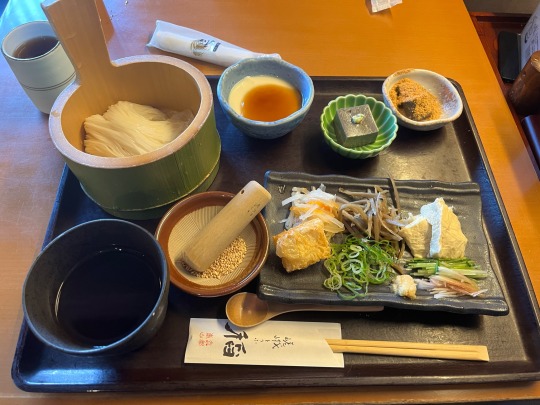
We then walked to the bridge to meet up with the group before hiking to go see the monkeys. While waiting there, a group of university students walked up to us to ask us to participate in a survey for them. It was on our views of caronavirus. They were really nice about it and both Lauren and I participated. I found it kinda funny that out of our whole group, they only asked Lauren and I.
Next, we hiked up to see the monkeys at the Iwatayama Monkey Park. My favorite part of the hike up is that they had a rest area partway up that had like a playground, and the best part a slide that was, and I quote, “out of order.” Bro, how’s a slide gonna be out of order??
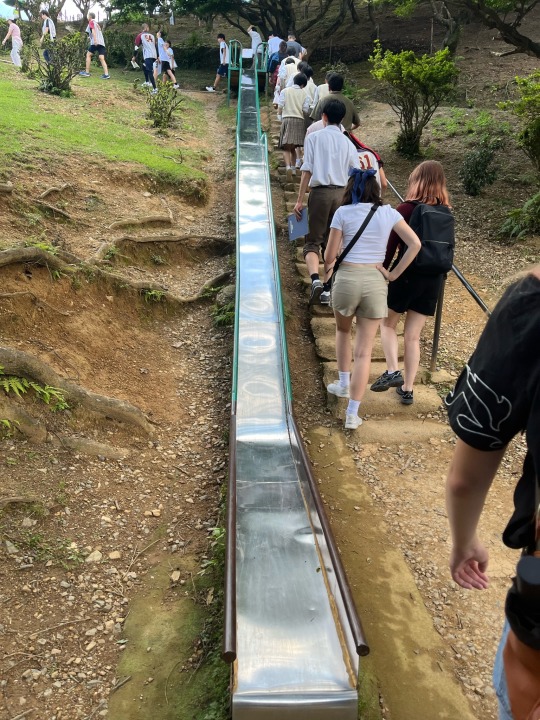
Eventually we made it to the top, and immediately when we got up there, we saw a mother with her baby walking by, which was quite cute. The view from the peak was my favorite view we got of Kyoto on the trip. It was very beautiful, especially since you could see Kyoto Tower my beloved.

I liked that the workers at the park had monkey friends that would hang out with them as well.

You could then also purchase apple pieces and peanuts to feed the monkeys through fencing. Everyone wanted to feel the babies of course, but the mom would just steal all the food. One thing that Lauren and I found hilarious is that the one mom would let her baby walk freely around, but the second it rounded the corner of the feeding area, she would chase him down and bring him back. Also, this entire time, and I’m talking the entire time, Lauren and I were going on about my “sir” bit. It’s something I started doing a while back where you just go like “sir, a moment of your time sir, a handshake if you will sir, sir it would mean the world to me for just a moment of your valuable time” and so on like that. I’m so glad Lauren likes that bit so much, as it’s one of my favorites and no one else has ever really seemed to appreciate it until her. It’s just something about saying it to like animals or like characters in video games or like statues even that absolutely cracks me up.
Feeding the monkeys was cool, but they had a limit on how much you could feed them. The monkeys very much preferred the apples over the peanuts, and it showed. Another thing that Lauren and I found hilarious was that the one mom would just drop food and crumbs on her baby whom she was holding. She wouldn’t share any food with the baby, but she would like crunch peanut shells over it’s head and it was really funny. We compared it to like using a baby as a lap napkin in a nice restaurant and dropping food on it.

On the way back to the hotel, Lauren and I got two different strawberry cakes to compare, and I got an Italian lemon soda in a glass bottle. We both agreed that the slightly more expensive cake was a lot better in every way, and I really liked my soda. Lauren tried the soda, but it was too sour for her taste.

For dinner, we got Emily to join us in going to a vegan place that had like pizza and pasta and burgers and stuff. I thought it was pretty alright, but they both seemed to really enjoy it which I was happy about. It’s been difficult for them to find good food on this trip, especially Emily who had said it was her first real meal in three days. Lauren and I then decided we would drag Emily to more meals with us for the rest of the trip so that she could eat.

Academic Reflection
Today I learned about the Arashiyama Bamboo Forest. It is an extremely popular tourist destination in Kyoto, and has over 10 million visitors per year. The land is protected, and houses a ton of bamboo, as well as cherry blossom trees, red pines, and others. Beginning in 1870, the Japanese government implemented a new forest management system focused on maintaining the ideal landscape and or function of different areas of forests. Under this legislation, the Arashiyama Bamboo Forest is protected due to its landscape. Seeing it in person, it honestly didn’t live up to the hype in my opinion, but it was still cool to see the bamboo forest and I understand why it is protected.
I also learned about The Tale of Genji and The Shrine in the Fields. In The Tale of Genji, Prince Genji and Lady Rokujō have an affair. Somewhere along the lines, Lady Rokujōs jealousy leads to the death of Genji’s wife. At least that is how this version of the Nō play depicts it. The Shrine in the Fields differs from this in the sense that Lady Rokujō is treated with sympathy and there is no notion that she caused Genji’s wife’s death. I find it interesting how different interpretations can arise from the same story. We unfortunately didn’t see any Nō performances on the trip, but it could’ve been cool if we did.
0 notes
Text
June 16 - Arashiyama

Today’s activities were the Arashiyama bamboo grove and the Iwatayama Monkey Park. After a 30ish minute train ride, we arrived at Arashiyama. The bamboo grove was spectacular. It was more beautiful than I remembered when I visited with my dad, probably because the weather was much nicer. We walked through the grove and stopped by the Nonomiya shrine. I enjoyed seeing this shrine, but needed to use the restroom, so Sumi and I had a side quest to find a restroom. We then walked along a huge river, which was very picturesque. I got some good juice along the way. A group of us then decided to eat at a vegan tofu place nearby. It was a very interesting meal; I had never eaten most of what was in the set in front of me and I didn’t even know what most of it was called. Although it was not really my taste, I enjoyed getting to have a cultural meal that I otherwise would not be able to have. We then ventured up a bit of an arduous climb to get to Iwatayama Monkey Park. Here, I fed some monkeys and watched them run around. The baby monkeys were the cutest.
The readings for today were a bit hard for me to get through if I’m being honest, but I appreciated the educational value of the topic of Arashiyama forest preservation. I found it interesting that the native plants to this area were not really mentioned to be bamboo at all (at least not that I can remember in the reading); rather, red pines, cedar trees, and cypress trees seemed to dominate the area before all of the bamboo was planted. Walking through the grove, I thought for a bit about how humans can bend nature to their will in this way, creating whatever we want to see in a natural area. I also did not realize just how many different legal designations this area has been through in its existence, which I found interesting. The other reading was related to one of the “love shrines,” Nonomiya-Jinju shrine. The reading was an English-translated excerpt from the Tale of Genji. This was cool to read about. I didn’t find myself thinking about it much during the activities today, but it is an important cultural text that nearly if not all Japanese schoolchildren must learn about and read during their school careers, much like we in America must read Shakespeare.
0 notes
Text
Letzter Tag in Kyoto mit der letzten Straßenbahn der Randen Tram Line die noch auf zwei kleinen Strecken hier fährt. Ansonsten fahren nur Busse oder Züge im Nahverkehr. Ziele waren in Arashiyama der Affenpark Iwatayama und der Nishiki-Markt in der Innenstadt.









1 note
·
View note
Text

Iwatayama Monkey Park
Arashiyama, Kyoto
6 notes
·
View notes
Photo



Baby Monkeys
Iwatayama Monkey Park, Arashiyama
2 notes
·
View notes
Photo

fox 1/2
~sticker pack~
instagram
#analog#lomo#lomography#35mm#film#photography#film is not dead#photographers on tumblr#artists on tumblr#vibrant#pale#pastel#philly#philadelphia#japan#travel#kyoto#monkey#iwatayama
6 notes
·
View notes
Text
Wednesday, May 27, 2024
Arashiyama Bamboo Forest and Iwatayama Monkey Park
Today began with the usual class meeting and bento box, I enjoyed this bento more than the last, as this one comes with some sort of ground beef and grilled beef resembling gyudon with rice. After our meeting we all made our way to the train station where we headed to Arashiyama. We got off and made our way down to the bamboo forest, which is a pretty popular tourist destination in Kyoto, and was busy as expected. Walking through it was pretty amazing though, as there was just a path for a while with massive bamboo on both sides of you as far as the eye can see. This was a pretty good walk, and it was a bit rainy so the vibes felt pretty nice given the environment, I also had an umbrella so it was nice to just walk in the rain with my friends.

The hike here led up the mountain to a place that is known for its dense population of monkeys, who have become accustomed to humans after being fed and turned into a tourist attraction. This was definitely one of my favorite parts of the trip by far, as seeing thede Japanese Macaque monkeys in person was pretty amazing. There were so many monkeys and they were just walking around amongst the humans, I was pretty curious what they might think of us since they really don’t pay much mind to their fellow primates. Seeing them all play in the forest climbing trees and running around had me a bit envious by the fact that they didn’t have to evolve sapience and pay taxes.


There was also an area where you could buy apples and peanuts for ¥100 and feed them to the monkeys through the fence grates. This was pretty jarring to see the monkeys stick their arms through begging for food like a hungry prisoner, but they have a pretty good life of sitting around and getting fed by humans. It was also weird that they can literally just grab the food out of your hand, the resemblance to human hands was a bit off-putting but still cool nonetheless. There was also a giant banana statue which was fitting for a place surrounded by monkeys, which Noah and I had to get a picture with.

After hanging out with the monkeys for a while longer my friends and I were getting a bit peckish and wanted to look for somewhere to eat down the mountain. We settled on a place called Saganoya, which was a Syokudo and Teishoku restaurant which was pretty solid. We all ordered different things and were pretty satisfied overall.

This meal satisfied our hunger cravings and post-meal we all walked around the area for a bit and browsed a few random shops. After this we found a bus to take us back to our hotel area since we were all pretty wet and wanted to change clothes/shower.


After this we went to Kawaramachi to play some games at Round One (I swear I’m not addicted to Maimai). After this we shopped around the area for a bit but I didn’t end up buying anything. After this I met up with a friend at Coco Ichibanya to get some Katsu Curry, which always hits the spot. This time i got a level 2 spice, one less than last time I went and somehow this time was spicier? Idk the logic behind that other than they just eyeball it every time. We then met up with some other friends to do some karaoke which was decently fun but most of my friends weren’t really into it I guess; so they left pretty early but i hung out a bit later and left after them.
Academic Reflection
The longer that I’m in Japan and the more things I get to see, the happier I am that they have taken the time for so many centuries to preserve vast swathes of nature. As the reading mentioned how Arashiyama Bamboo Forest has actually been preserved since the Heian period, roughly 1200 years ago which is pretty insane to me. It definitely was a sight to see and being at the forest really made me feel grateful that they didn’t pull an America and destroy all of the beautiful nature to be replaced with a walmart or something. Though despite these efforts, it’s impossible to prevent degradation by means of natural causes. Things like overpopulation of animals, plant disease, and typhoons have harmed the ecosystem of the Arashiyama bamboo forest.
The second reading today was a chapter from the famous text, “The Tale of Genji” which I was able to connect with as the Nonomiya-Jinja shrine which is located in Arashiyama, is a key location in the text that we read. This was also pretty cool to have walked in an area which was mentioned in an 11th century story. For me, this reading was a bit difficult to keep track of how the events unfolded, which I’m noticing is a common theme among traditional Japanese stories, as they tend to become pretty convoluted with many different things happening and keeping track of who is who becomes tricky. The shrine that we went to is famous for its unstripped wooden torii gate. It is also known as the shrine for lovers, and used to be temporary, being rebuilt time and time again. However it has since become a permanent fixture and a staple of the Arashiyama Bamboo Forest area.

1 note
·
View note
